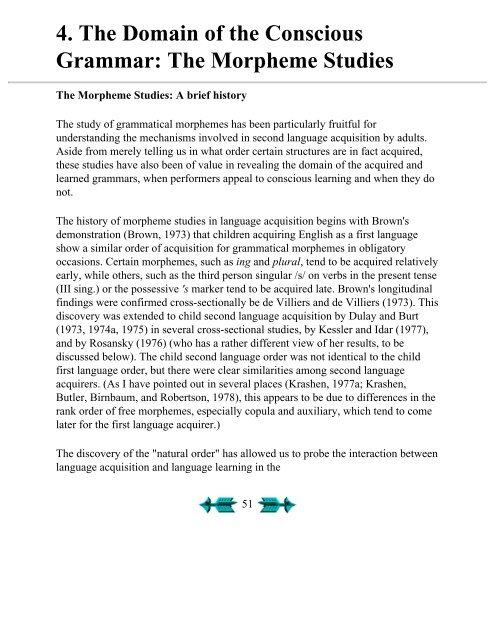Second Language Acquisition and Second ... - Stephen Krashen
Second Language Acquisition and Second ... - Stephen Krashen
Second Language Acquisition and Second ... - Stephen Krashen
Create successful ePaper yourself
Turn your PDF publications into a flip-book with our unique Google optimized e-Paper software.
4. The Domain of the Conscious<br />
Grammar: The Morpheme Studies<br />
The Morpheme Studies: A brief history<br />
The study of grammatical morphemes has been particularly fruitful for<br />
underst<strong>and</strong>ing the mechanisms involved in second language acquisition by adults.<br />
Aside from merely telling us in what order certain structures are in fact acquired,<br />
these studies have also been of value in revealing the domain of the acquired <strong>and</strong><br />
learned grammars, when performers appeal to conscious learning <strong>and</strong> when they do<br />
not.<br />
The history of morpheme studies in language acquisition begins with Brown's<br />
demonstration (Brown, 1973) that children acquiring English as a first language<br />
show a similar order of acquisition for grammatical morphemes in obligatory<br />
occasions. Certain morphemes, such as ing <strong>and</strong> plural, tend to be acquired relatively<br />
early, while others, such as the third person singular /s/ on verbs in the present tense<br />
(III sing.) or the possessive 's marker tend to be acquired late. Brown's longitudinal<br />
findings were confirmed cross-sectionally be de Villiers <strong>and</strong> de Villiers (1973). This<br />
discovery was extended to child second language acquisition by Dulay <strong>and</strong> Burt<br />
(1973, 1974a, 1975) in several cross-sectional studies, by Kessler <strong>and</strong> Idar (1977),<br />
<strong>and</strong> by Rosansky (1976) (who has a rather different view of her results, to be<br />
discussed below). The child second language order was not identical to the child<br />
first language order, but there were clear similarities among second language<br />
acquirers. (As I have pointed out in several places (<strong>Krashen</strong>, 1977a; <strong>Krashen</strong>,<br />
Butler, Birnbaum, <strong>and</strong> Robertson, 1978), this appears to be due to differences in the<br />
rank order of free morphemes, especially copula <strong>and</strong> auxiliary, which tend to come<br />
later for the first language acquirer.)<br />
The discovery of the "natural order" has allowed us to probe the interaction between<br />
language acquisition <strong>and</strong> language learning in the<br />
51











